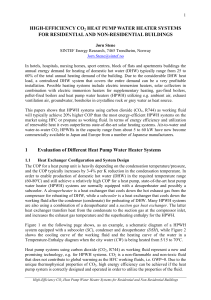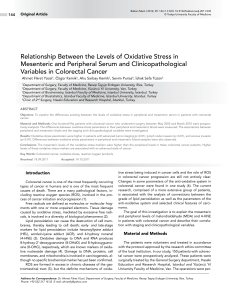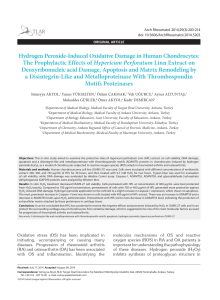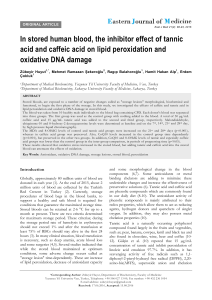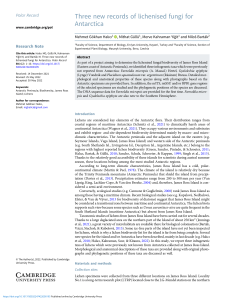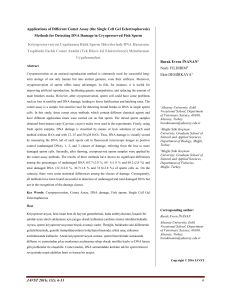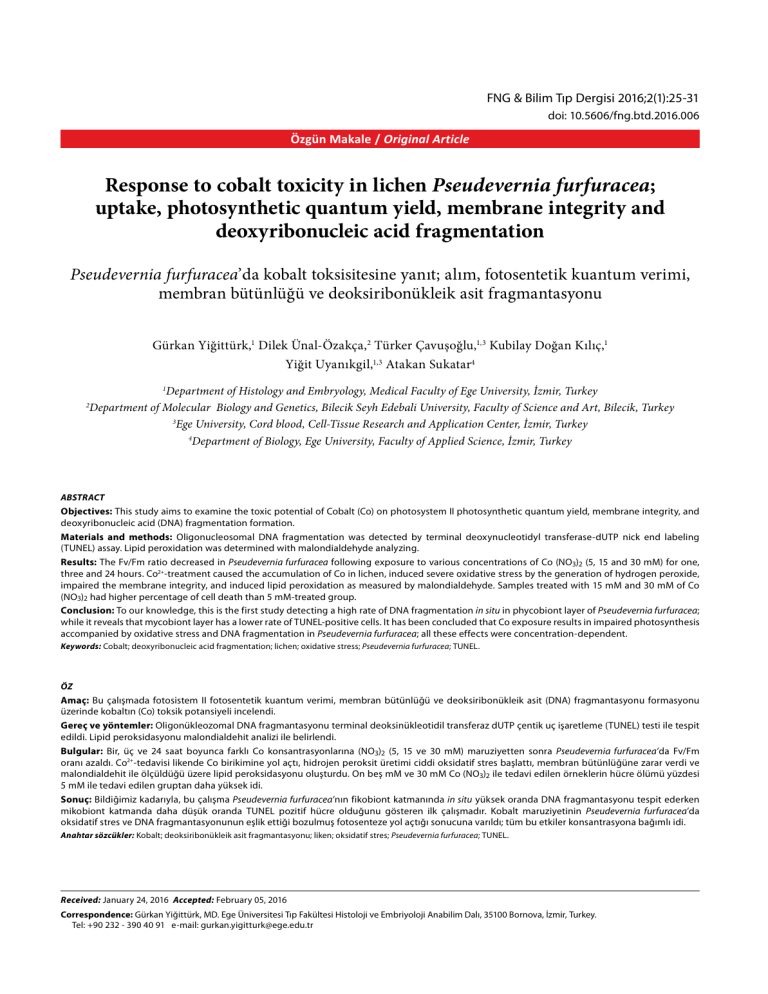
FNG & Bilim Tıp Dergisi 2016;2(1):25-31
doi: 10.5606/fng.btd.2016.006
Özgün Makale / Original Article
Response to cobalt toxicity in lichen Pseudevernia furfuracea;
uptake, photosynthetic quantum yield, membrane integrity and
deoxyribonucleic acid fragmentation
Pseudevernia furfuracea’da kobalt toksisitesine yanıt; alım, fotosentetik kuantum verimi,
membran bütünlüğü ve deoksiribonükleik asit fragmantasyonu
Gürkan Yiğittürk,1 Dilek Ünal-Özakça,2 Türker Çavuşoğlu,1,3 Kubilay Doğan Kılıç,1
Yiğit Uyanıkgil,1,3 Atakan Sukatar4
Department of Histology and Embryology, Medical Faculty of Ege University, İzmir, Turkey
Department of Molecular Biology and Genetics, Bilecik Seyh Edebali University, Faculty of Science and Art, Bilecik, Turkey
3
Ege University, Cord blood, Cell-Tissue Research and Application Center, İzmir, Turkey
4
Department of Biology, Ege University, Faculty of Applied Science, İzmir, Turkey
1
2
ABSTRACT
Objectives: This study aims to examine the toxic potential of Cobalt (Co) on photosystem II photosynthetic quantum yield, membrane integrity, and
deoxyribonucleic acid (DNA) fragmentation formation.
Materials and methods: Oligonucleosomal DNA fragmentation was detected by terminal deoxynucleotidyl transferase-dUTP nick end labeling
(TUNEL) assay. Lipid peroxidation was determined with malondialdehyde analyzing.
Results: The Fv/Fm ratio decreased in Pseudevernia furfuracea following exposure to various concentrations of Co (NO3)2 (5, 15 and 30 mM) for one,
three and 24 hours. Co2+-treatment caused the accumulation of Co in lichen, induced severe oxidative stress by the generation of hydrogen peroxide,
impaired the membrane integrity, and induced lipid peroxidation as measured by malondialdehyde. Samples treated with 15 mM and 30 mM of Co
(NO3)2 had higher percentage of cell death than 5 mM-treated group.
Conclusion: To our knowledge, this is the first study detecting a high rate of DNA fragmentation in situ in phycobiont layer of Pseudevernia furfuracea;
while it reveals that mycobiont layer has a lower rate of TUNEL-positive cells. It has been concluded that Co exposure results in impaired photosynthesis
accompanied by oxidative stress and DNA fragmentation in Pseudevernia furfuracea; all these effects were concentration-dependent.
Keywords: Cobalt; deoxyribonucleic acid fragmentation; lichen; oxidative stress; Pseudevernia furfuracea; TUNEL.
ÖZ
Amaç: Bu çalışmada fotosistem II fotosentetik kuantum verimi, membran bütünlüğü ve deoksiribonükleik asit (DNA) fragmantasyonu formasyonu
üzerinde kobaltın (Co) toksik potansiyeli incelendi.
Gereç ve yöntemler: Oligonükleozomal DNA fragmantasyonu terminal deoksinükleotidil transferaz dUTP çentik uç işaretleme (TUNEL) testi ile tespit
edildi. Lipid peroksidasyonu malondialdehit analizi ile belirlendi.
Bulgular: Bir, üç ve 24 saat boyunca farklı Co konsantrasyonlarına (NO3)2 (5, 15 ve 30 mM) maruziyetten sonra Pseudevernia furfuracea’da Fv/Fm
oranı azaldı. Co2+-tedavisi likende Co birikimine yol açtı, hidrojen peroksit üretimi ciddi oksidatif stres başlattı, membran bütünlüğüne zarar verdi ve
malondialdehit ile ölçüldüğü üzere lipid peroksidasyonu oluşturdu. On beş mM ve 30 mM Co (NO3)2 ile tedavi edilen örneklerin hücre ölümü yüzdesi
5 mM ile tedavi edilen gruptan daha yüksek idi.
Sonuç: Bildiğimiz kadarıyla, bu çalışma Pseudevernia furfuracea’nın fikobiont katmanında in situ yüksek oranda DNA fragmantasyonu tespit ederken
mikobiont katmanda daha düşük oranda TUNEL pozitif hücre olduğunu gösteren ilk çalışmadır. Kobalt maruziyetinin Pseudevernia furfuracea’da
oksidatif stres ve DNA fragmantasyonunun eşlik ettiği bozulmuş fotosenteze yol açtığı sonucuna varıldı; tüm bu etkiler konsantrasyona bağımlı idi.
Anahtar sözcükler: Kobalt; deoksiribonükleik asit fragmantasyonu; liken; oksidatif stres; Pseudevernia furfuracea; TUNEL.
Received: January 24, 2016 Accepted: February 05, 2016
Correspondence: Gürkan Yiğittürk, MD. Ege Üniversitesi Tıp Fakültesi Histoloji ve Embriyoloji Anabilim Dalı, 35100 Bornova, İzmir, Turkey.
Tel: +90 232 - 390 40 91 e-mail: [email protected]
26
FNG & Bilim Tıp Dergisi
Cobalt (Co) is an element that occurs naturally in
many different chemical forms in the environment.
It is an essential element for the synthesis of
vitamin B, which is required for human and
animal nutrition.[1] However, high concentrations
of Co are inhibitory for growth, chlorophyll
synthesis and induce changes in photosynthetic
activity.[2-4] Toxicity symptoms due to excess Co
are chlorosis, necrosis, and root tip damage in
higher plants.
Lichens are potentially useful in the monitoring
of heavy metal pollution. Their reaction to
pollution is a consequence of the fact that,
comparing to plant species, they do not have
an outer covering tissue which facilitates direct
penetration of gases, dusts and solutions inside
the thalli. Some lichen species can accumulate
large quantities of metals.[5] However, high
concentrations of heavy metals may cause damage
to the lichen thalli. Cobalt bioaccumulation and
biosorption has been recently studied; however,
there are no data available on the effect of Co
on the cellular processes in lichens. This study
aimed to investigate the potential toxic effect of
Co on photosynthesis, oxidative stress, and DNA
fragmentation.[6,7]
MATERIALS AND METHODS
Pseudevernia furfuracea (L.) Zopf samples were
collected from bark of Pinus in Karagöl, IzmirTurkey (38°33' N 27°13' E, 840 m). Lichens
transferred to the laboratory were rinsed three
times (10 s each) to minimize dust contamination
and divided into groups. Experiments were
conducted within 3-4 days of collection. The
test solutions were prepared just before the
experiments. Samples were incubated for 1 h in
solutions of Co(NO3)2 dissolved in bidistilled water
(5 mM, 15 mM and 30 mM); control samples
were soaked in distilled water. After incubation,
lichen thalli were kept for 24 h under laboratory
conditions.
For the determination of Co content, the threestage microwave-assisted digestion procedure
was applied using a microwave oven (Berghof,
speedwave) under a pressure of 8 atm. In the
first stage, lichen sample (0.5 g) was washed
three times with distilled water and decomposed
with 5 mL of HNO3 for 10 min. The sample was
cooled, vented to remove NO2 and CO2 and 1 mL
of H2O2 was added. The vessel was capped and
subjected to microwave attack for 10 min (second
stage). In the third stage, 1 mL of hydrogen
fluoride was added and the sample was processed
for 10 min. After cooling, the sample was
transferred to a polytetrafluoroethylene (PTFE)
evaporating dish and evaporated to dryness. The
residue was then processed as described above.
Co concentration was measured by inductively
coupled plasma optical emission spectrometer
(ICP-OES). Each treatment was comprised of
three replicates.
For the detection of photosynthetic capacity
of lichen, chlorophyll a fluorescence of samples
was measured with a plant efficiency analyzer
(Handy PEA, Hansatech). Before measurement
of chlorophyll fluorescence, the thalli were darkadapted for 15 min. The Fv/Fm parameter was
calculated by the instrument from fluorescence
induction curves of 5 s duration recorded at an
irradiance of 1800 µmol m-2s-1 from light emitting
diodes. The Fv/Fm parameter defines the maximum
quantum yield efficiency of photosystem II (PSII) and
was used as a stress indicator. Time-dependency of
the effect of Co on PSII was also tested in thalli
samples exposed to 5 mM, 15 mM and 30 mM
Co(NO3)2 for 1, 3 and 24 h.
Electrical conductivity (EC) as an index of
cellular membrane integrity was measured.
Batches of lichen thalli were divided into
subsamples of 1 g and immersed in 100 mL
of double-distilled water for 60 min. Electrical
conductivity of the water was measured by an
EC meter (WTW Cond 340i) and is used as a
measure of electrolyte leakage to the incubation
solution.
Formation of malondialdehyde (MDA) was
evaluated as an indicator of lipid peroxidation.
Determination of MDA was performed by the
thiobarbituric acid reactive substances method.[8]
The absorbance differences between 532 and
600 nm was used to calculate MDA formation
as a by-product of lipid peroxidation. Each
treatment was comprised of three replicates.
Hydrogen peroxide (H 2 O2 ) levels were
determined according to Sergiev et al.[9] Leaf
tissues of 0.5 g were homogenized in ice bath
with 5 mL 0.1% (w/v) trichloroacetic acid. The
homogenate was centrifuged at 12,000 g for
15 min and 0.5 mL of supernatant was added to
27
Response to cobalt toxicity in lichen Pseudevernia furfuracea
For DNA fragmentation assay, the thallus
was cut into the small pieces and then fixed with
FAA solution (50% ethanol, 5% glacial acetic
acid, 3.7% formaldehyde, freshly prepared)
and incubated in this solution overnight. Fixed
samples were dehydrated through an ethanol
series (50%, 70%, 80%, 95%, 100% for 15 min
each concentration), immersed in ethanol-xylene
(1:1) for 10 min and then in 100% xylene
for 10 min. The samples were embedded in
paraffin, and cut to 5 µm sections in Leica RM
2145 microtome (Leica Microsystems, RM2145,
Glattbrugg, Switzerland).
Immunohistochemical
expression
was
analyzed in the lichen thallus tissue using
peroxidase as described in details below. Paraffin
sections were immersed in xylene overnight and
immunohistochemical terminal deoxynucleotidyl
transferase dUTP nick end labeling (TUNEL)
staining was performed as follows: sections were
incubated for 20 min in methanol containing
1% H2O2 to reduce endogenous peroxidase
activity and then exposed to microwave in
sodium citrate solution for five minute 90 watt
- 15 minute 360 watt. After washing in 0.2 M
Tris-HCl including 0.5% Triton X, the sections
were exposed to the TUNEL (Promega TUNEL
Systems Cat. # G7130-G7360). Finally, sections
were reacted with 0.05% diaminobenzidine
(Zymed Histostain Plus Ref/Cat No: 859643
San Francisco California, USA) and H 2O2
(0.01%). Immunoreaction was assessed by light
microscopy (Olympus BX-51 light microscope,
Olympus C-5050 digital camera; Olympus Co.,
Tokyo, Japan) at a magnification of X100.
TUNEL (+) cells were counted in the lichen
thallus using image software (Image-Pro Express
4.5, Media-Cybernetics Inc., Rockville, MD,
USA). Cell density (cells µm2) was calculated for
lichen and the average TUNEL (+) cell density
was obtained in each group.
Statistical analysis
Data were expressed as the mean ± standard
error of the mean (SEM). One-way analysis of
variance (ANOVA) was performed for the statistical
analysis of Fv/Fm ratios and nonparametric
Kruskal Wallis test for independent samples was
performed for the rest of the analysis. P<0.05 was
accepted significant; when a P value below 0.05
was determined, Bonferroni test or Mann Whitney
U test was carried out in post hoc analysis for the
comparison of groups where appropriate SPSS
for Windows version 11.0 version software (SPSS
Inc., Chicago, IL, USA).
RESULTS
ICP-OES data showed that the concentration
of Co in the untreated thallus of P. furfuracea
soaked in bidistilled water was 3.49±0.04 μg/g
dry weight. On the other hand, treatment
of thalli with 5 mM, 15 mM, and 30 mM
Co(NO3)2 for 1 h resulted in a significant dosedependent increase in the Co content of thallus
(64.12±11.37, 108.63±0.58 and 216.17±3.62
μg/g dry weight, respectively; p<0.05 when
compared to control group and when compared
to exposure groups with each other).
For the estimation of the effect of Co
on photosynthesis capacity of the thallus,
photoinhibition was measured with permanent
reduction in maximal PSII efficiency (Fv/Fm).
There was a gradual, time- and dose-dependent
decrease in the Fv/Fm values in Co2+-exposure
0.8
#
*
##
**
††
***
0.6
Fv/Fm ratio
0.5 mL of 10 mM potassium phosphate buffer
(pH 7.0) and 1 mL 1 M potassium iodide. The
absorbance of supernatant was read at 390 nm.
The content of H 2O2 was calculated based on a
standard curve.
†
***
†††
*
†††
‡
###
***
||
†††
###
***
0.4
¶
†††
‡
###
***
0.2
0.0
1h
Control
3h
5 mM
24 h
15 mM
30 mM
Figure 1. Fv/Fm ratio of P. furfuracea thalli immersed
in bidistilled water or in different concentrations of Co
(NO3)2. Data are presented as mean ± SEM of eight individual experi-
ments. * P<0.05, ** P<0.01 and *** P<0.001, when compared to control;
# P<0.05, ## P<0.01 and ### P<0.001, when compared to 5 mM group;
‡ P<0.001, when compared to 15 mM group; † P<0.05, †† P<0.01 and
††† P<0.001, when compared to corresponding 1 hour exposure data;
§ P<0.05, || P<0.01 and ¶ P<0.001, when compared to corresponding
3 hours exposure data.
28
FNG & Bilim Tıp Dergisi
Table 1. Electrical conductivity and malondialdehyde and hydrogen peroxide content of
P. furfuracea thalli incubated in bidistilled water (control) or in different concentrations of Co (NO3)2
for 24 hours
Electrical conductivity (µS cm-1)
Mean±SEM
Malondialdehyde (µM)
H2O2 (µM)
Mean±SEMMean±SEM
Control
2.53±0.26
1.72±0.541.66±0.12
3.33±0.60
2.43±0.016.23±0.10*
5 mM Co(NO3)2
15 mM Co(NO3)2
9.40±0.56*,‡
7.51±0.67*,‡11.79±0.20*,‡
30 mM Co(NO3)218.77±0.59*,‡,¶14.38±0.26*,‡,¶51.53±2.07*,‡,¶
SEM: Standard error of the mean; H2O2: Hydrogen peroxide; * P<0.05, when compared to control; ‡ P<0.05, when compared to
5 mM group; ¶ P<0.05, when compared to 15 mM group.
groups, indicating a significant photodestructive
effect on PSII (Figure 1).
Cellular membrane integrity was assessed
by the measurement of EC in the incubation
solution. It was noticed that Co2+ exposure of
thalli for 24 h increased the EC at 15 and 30 mM
concentrations significantly when compared to
the control group (P<0.05, Table 1) and this
effect was concentration-dependent; indicating a
marked impairment in the membranal integrity of
the thalli.
Table 1 shows the MDA and H2O2 content
of thalli after exposure to Co2+ for 24 h. Co2+
exposure significantly increased the MDA content
of thalli at 15 mM and 30 mM, but not at 5 mM,
concentrations (p<0.05), while it increased H2O2
content at all concentrations. The increase in
MDA level, as an index of lipid peroxidation, and
H2O2 level was in a concentration-dependent
manner.
Tissue sections of thallus from P. furfuracea
were examined for TUNEL-positive nuclei, which
(a)
(b)
(c)
(d)
Figure 2. TUNEL staining of the sections of lichen incubated in (a) bidistilled water (control
group), (b) 5 mM Co(NO3)2, (c) 15 mM Co(NO3)2 or (d) 30 mM Co(NO3)2. Original
magnification x 40. Scale bar= 125 µm. Dark nuclei are TUNEL (+) cells.
29
Response to cobalt toxicity in lichen Pseudevernia furfuracea
Number of TUNEL (+) cells/area
50
‡
#
*
40
#
*
30
20
10
*
0
Control
5 mM
15 mM
30 mM
Figure 3. Number of TUNEL (+) cells in lichen thallus
sections. Data are presented as mean ± SEM of three individual
experiments. * P<0.001, when compared to control; # P<0.001, when
compared to 5 mM group; ‡ P<0.001, when compared to 15 mM group.
were noticed as dark brown spots (Figure 2). In
mycobiont layer, TUNEL-positive nuclei were
less frequently scattered in Co2+ exposure
groups comparing to the intensity of TUNELpositive nuclei in the phycobiont layer of thallus
(Figure 2). In total, exposure of thalli to Co2+
resulted in a significant increase in the number
of TUNEL-positive cells in a concentrationdependent manner (p<0.001, Figure 3). When
the distribution of TUNEL-positive cells among
the two layers of lichen was statistically examined;
it was noticed that the percentage of TUNELpositive cells in the photobiont was higher than
the mycobiont both in the control group (p<0.05)
and in the Co2+ exposure groups (p<0.01 in 5
and 30 mM groups and p<0.001 15 mM group)
(Table 2).
Table 2. The percentage of TUNEL positive nuclei of
mycobiont and photobiont layers of P. furfuracea thalli
immersed in bidistilled water (control) or in different
concentrations of Co(NO3)2 for 24 hours
TUNEL positive nuclei (%)
MycobiontPhotobiont
Mean±SEMMean±SEM
Control
0.70±0.081.30±0.20 ¶
4.02±0.17 *
23.33±1.67*,§
5 mM Co(NO3)2
15 mM Co(NO3)210.52±0.77*,†65.65±0.59*,†,||
30 mM Co(NO3)237.24±3.08*,†,‡82.02±1.52*,†,‡,§
SEM: Standard error of the mean; P<0.05, when compared to control;
† P<0.05, when compared to 5 mM group; ‡ P<0.05, when compared to 15
mM group; ¶ P<0.05, § P<0.01, || P<0.001, when compared to mycobiont
layer.
DISCUSSION
Lichens do not shed plant parts as readily
as vascular plants.[5,10] The lack of a waxy
cuticle and stomata allows them to adsorb
many contaminants through the whole lichen
surface.[5] Lichens are capable of accumulating
various elements to concentrations that vastly
exceed their physiological requirements and
therefore, deposition patterns are distinguishable
from normal element loadings.[5] Data obtained
in lichen samples incubated in Co(NO3)2
in our study show that Co content rapidly
increases in P. furfuracea with the increasing
Co concentration in the incubation solution.
Exposure to Co(NO3)2 produced an accumulation
of Co in P. furfuracea thallus at a considerably
high level (i.e. 216.73 μg/g dry weight at
exposure to 30 mM Co2+) that had a capacity to
inhibit photosynthesis significantly.
Maximal PSII efficiency is frequently used
to monitor stress in photosynthetic organisms.
Under
non-stressed
conditions,
lichens
typically possess a Fv/Fm ratio in the range of
0.45-0.65.[11] The decrease of Fv/Fm ratio in the
lichen P. furfuracea is in accordance with studies
on the impact of Co2+ stress on algae.[12] Plekhanov
and Chemeris[12] showed that the Fv/Fm ratio in
Chlorella pyrenoidosa treated with 0.1, 1, and
10 mM Co2+, rapidly decreased to 0.45, 0.25,
and 0.15, respectively. In the present study,
24-hour exposure to Co2+ resulted in Fv/Fm
values of 0.47 and 0.1 at 15 mM and 30 mM
concentrations; suggesting that particularly at
30 mM, Co2+ decreases the photosynthesis
capacity of lichen below the non-stressed levels
and induces significant photo-destructive effects
on PSII, respectively.
Oxidative stress caused lipid peroxidation
and thereby destruction of cell membranes.
[13]
Although the toxicity of Co is quite low
compared to many other metals in soil, the toxic
action of Co was found to be altering membrane
permeability.[14,15] Turton et al.[16] suggested that
the presence of MDA in biological systems can
be related to the peroxidation of unsaturated
fatty acids constituting cellular membranes. The
consequences of the changes in lipid and protein
structure are the loss of membrane integrity and
selective permeability. Thus, the increase in
MDA levels suggests that higher concentration
30
FNG & Bilim Tıp Dergisi
of Co2+ has a damaging effect on the cellular
membranes of P. furfuracea. In present study,
the concentration-dependent increase in MDA
levels shows a positive correlation with the EC
values in such a manner that the higher MDA
levels in lichen, the higher EC in the incubation
solution. Electrical conductivity is considered to
indicate injury to cell membranes and has been
previously used for the assessment of electrolyte
leakage in lichen.[17,18] Although 5 mM Co2+exposure did not significantly change EC in
thalli, marked higher EC values were observed
in thalli treated with 5 mM and 30 mM
concentration of Co2+; indicating the leakage of
electrolytes through the damaged membranes of
the lichen.
is required to investigate the characteristics of
the formation of DNA fragmentation related to
necrosis or apoptosis in lichen under heavy metal
stress conditions.
H2O2 is toxic for most animal cells at levels
of about 10-102 μM.[19] Experiments with plant
material have demonstrated that plant tissues
can tolerate high concentrations of H2O2 in the
range of 102-2x105 μM.[20] H2O2 increase has been
reported in Arabidopsis thaliana and tomato
plants after treatment with copper, cadmium and
mercury.[21-23] Photosynthetic efficiency data in
our study has shown that thallus of P. furfuracea
can tolerate concentrations of H 2O2 at an
approximate range of 6-52 µM (see Table 1).
de Pinto et al.[24] showed that only simultaneous
increase of H2O2 in tobacco cells induced cell
death that had typical cytological and biochemical
features of DNA fragmentation. Similarly, our
results have shown that increasing production
of H2O2 induces a marked increase in the
density of TUNEL-positive cells in P. furfuracea
thalli. TUNEL-positive nuclei were examined less
frequently in mycobiont layer compared to the
photobiont layer, suggesting the photobiont layer
is more sensitive to Co-induced toxicity than
mycobiont layer.
REFERENCES
In conclusion, our data have clearly indicated
that exposure to Co2+ increases the Co content of
the lichen and consequently results in decreased
photosynthetic quantum yield. This functional
Co toxicity is accompanied by lipid peroxidation
and consecutive damage to cellular membrane
integrity and oxidative stress-induced formation of
DNA fragmentation especially in the photobiont
layer. Results of the present study, however,
do not clearly identify that the feature of DNA
fragmentation is directly related to apoptotic-like
formation or necrosis. Further focused research
Acknowledgments
The authors of the current study would like to thank
Dr. enol Sert for helping the ICP-OES analysis.
Declaration of conflicting interests
The authors declared no conflicts of interest with
respect to the authorship and/or publication of this article.
Funding
The authors received no financial support for the
research and/or authorship of this article.
1. Munda LM, Hudnik V. The effect of Zn, Mn and Co
accumulation on growth and chemical composition
of Fucus vesiculosus under different temperature and
salnity conditions. Mar Ecol 1988;9:213-5.
2. Csatorday K, Gombos Z, Szalontai B. Mn and Co
toxicity in chlorophyll biosynthesis. Proc Natl Acad Sci
U S A 1984;81:476-8.
3. El-Naggar AH, Osman MEH, Dyab MA, El-Mohsenawy
EA. Co and lead toxicities on Calothrix fusca and
Nostoc muscorum. Egypt J Bot 1999;421-41.
4. Tiwari S, McHanty P. Cobalt induced changes in
photosystem activity in Synechocystis PCC 6803:
Alterations in energy distribution and stoichiometry.
Photosynth Res 1996;50:243-56.
5. Nash III TH. Lichen Biology. New York: Cambridge
University Press; 1996. p. 147-50.
6. Pipíska M, Horník M, Vrtoch L, Augustín J, Lesny
J. Biosorption of Co2+ ions by lichen Hypogymnia
physodes from aqueous solutions. Biologia
2007;62:276-82.
7. Freitas MC, Pacheco AMG. Bioaccumulation of Co in
Parmelia sulcata. J Atmos Chem 2004;49:67-82.
8. Heath RL, Packer L. Photoperoxidation in isolated
chloroplasts. I. Kinetics and stoichiometry of
fatty acid peroxidation. Arch Biochem Biophys
1968;125:189-98.
9. Sergiev I, Alexieva V, Karanov E. Effect of spermine,
atrazine and combination between them on some
endogenous protective systems and stress markers in
plants. Compt Rend Acad Bulg Sci 1997;51:121-4.
10.Loppi S, Pirintsos SA, de Dominicis V. Soil
contribution to the elemental composition of epiphytic
lichens (Tuscany, central Italy). Environ Monit Assess
1999;58:121-31.
11.Kappen L, Schroeter B, Green TGA, Seppelt RD.
Chlorophyll a fluorescence and CO2 exchange of
Umblicaria aprina under extreme light stress in the
cold. Oecologia 1998;113:325-31.
Response to cobalt toxicity in lichen Pseudevernia furfuracea
12. Plekhanov SE, Chemeris IuK. Early toxic effect of
zinc, cobalt, and cadmium on photosynthetic activity
of green alga Chlorella pyrenoidosa Chick S-39. Izv
Akad Nauk Ser Biol 2003;5:610-6. [Abstract]
13. Vangronsveld J, Clijsters H. Toxic effects of metals. In:
Farago ME, editor. Plants and the Chemical Elements.
Biochemistry, Uptake, Tolerance and Toxicity.
Weinheim: VCH Verlagsgesellschaft Publishers; 1994.
p. 149-77.
14. Rachlin JW, Grosso A. The growth response of the
green alga Chlorella vulgaris to combined divalent
cation exposure. Arch Environ Contam Toxicol
1993;24:16-20.
15. Osman ME, El-Naggar AH, El-Sheekh MM, El-Mazally
EE. Differential effects of Co(2+) and Ni(2+) on
protein metabolism in Scenedesmus obliquus and
Nitzschia perminuta. Environ Toxicol Pharmacol
2004;16:169-78.
16. Turton HE, Dawes IW, Grant CM. Saccharomyces
cerevisiae exhibits a yAP-1-mediated adaptive response
to malondialdehyde. J Bacteriol 1997;179:1096-101.
17.Garty J, Cohen Y, Kloog N, Karnieli A. Effects of
air pollution on cell membrane integrity, spectral
reflectance and metal and sulfur concentrations in
Lichens. Environ Toxicol Chem 1997;16:1396-402.
18. Backor M, Fahselt D, Davidson RD, Wu CT. Effects
of copper on wild and tolerant strains of the lichen
31
photobiont Trebouxia erici (Chlorophyta) and possible
tolerance mechanisms. Arch Environ Contam Toxicol
2003;45:159-67.
19.Halliwell B, Gutteridge JMC. The chemistry of free
radicals and related reactive species. In: Free radicals
in biology and medicine. Oxford: Oxford University
Press; 1999. p. 36-104.
20. Slesak I, Libik M, Karpinska B, Karpinski S,
Miszalski Z. The role of hydrogen peroxide in
regulation of plant metabolism and cellular signalling
in response to environmental stresses. Acta Biochim
Pol 2007;54:39-50.
21.Romero-Puertas MC, Rodriquez-Serrano M, Corpas
FJ, Go´mez M, Del Rio LA, Sandalio LM. Cadmiuminduced subcellular accumulation of O2- and H2O2 in
pea leaves. Plant Cell Environ 2004;27:1122-34.
22.Maksymiec W, Krupa Z. The effects of short-term
exposition to Cd, excess Cu ions and jasmonate on
oxidative stress appearing in Arabidopsis thaliana.
Environ Exp Bot 2006;57:187-94.
23. Cho U, Park J. Mercury-induced oxidative stress in
tomato seedlings. Plant Sci 2000;156:1-9.
24. de Pinto MC, Tommasi F, De Gara L. Changes in the
antioxidant systems as part of the signaling pathway
responsible for the programmed cell death activated
by nitric oxide and reactive oxygen species in tobacco
Bright-Yellow 2 cells. Plant Physiol 2002;130:698-708.

